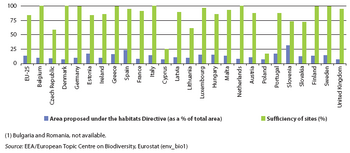Archive:Biodiversity statistics
- Data from October 2008, most recent data: Further Eurostat information, Main tables and Database.
Biodiversity, a contraction of biological diversity, reflects the number, variety and variability of living organisms, including mankind. The global scale of the biodiversity issue has led to international action within this domain, with the framework for action being the United Nations (UN) Convention on biological diversity (CBD), which the European Union (EU) ratified in 1993. In 1998, the EU adopted a biodiversity strategy.
Main statistical findings
Protected areas for biodiversity are based on areas proposed by countries under the Habitats Directive and reflect the share of the total area of a country. About 13 % of the EU-25’s territory was considered as a protected area in 2007, but individual Member States can have a much higher share, for example, a little above 30 % in Slovenia.
There was a negative trend in the past 25 years for common bird species, in particular for common farmland birds, which have become more threatened during the period considered. Part of the relatively steep decline in numbers of common farmland bird species may be explained by changes in land use and agricultural practices which affect birds’ capacity for nesting or feeding. After a couple of years of limited upturn, the population of farmland species fell relatively sharply again in 2006. In contrast, the index for forest birds showed some improvement compared with its relative low recorded in 2000, despite a contraction between 2004 and 2005.
Data sources and availability
Annual data are available on protected areas under the habitats Directive and these are presented as a percentage of total country area. The indicator on protected areas is based on territories proposed by countries to be designated for the protection of natural and semi-natural habitats, wild fauna and flora according to the habitats Directive. The index of sufficiency measures the extent to which sites of Community importance proposed by the Member States adequately cover the species and habitats listed in the annexes I and II of the Habitats Directive.
Birds are considered good proxies for biodiversity and the integrity of ecosystems as they tend to be at, or near, the top of the food chain, have large ranges and can migrate and thus reflect changes in ecosystems rather rapidly. By focusing attention on the population trends of relatively large groups of abundant European species associated with different habitats, these indicators are designed to capture the overall, average changes in population levels of common birds to reflect the health and functioning of ecosystems. The population index of common birds is an aggregated index (with base year 1990 or the first year the Member State entered the scheme) of population trend estimates of a selected group of common bird species. Indices are calculated for each species independently and are then combined to create a multi-species EU indicator by averaging the indices with an equal weight using a geometric mean. Indices are averaged rather than bird abundance in order to give each species an equal weight in the resulting indicator. The EU index is based on trend data from 18 Member States, derived from annually operated national breeding bird surveys obtained through the Pan-European common bird monitoring scheme (PECBMS). Three different indices are presented, covering: farmland (36 species), forest (29 species) and ’all common birds’ (135 species). For the first two categories, the bird species have a high dependence on the habitats in the nesting season and for feeding during most of the year; the aggregate index regroups farmland and forest species together with other common species.
Context
Biodiversity, a contraction of biological diversity, reflects the number, variety and variability of living organisms, including mankind. The global scale of the biodiversity issue has led to international action within this domain, with the framework for action being the United Nations (UN) Convention on biological diversity (CBD), which the EU ratified in 1993. In 1998, the EU adopted a biodiversity strategy. Four biodiversity action plans were adopted under this strategy in 2001 (conservation of natural resources, agriculture, fisheries, economic and development cooperation). At the United Nations world summit on sustainable development in Johannesburg in 2002, governments committed themselves to significantly reducing the rate of biodiversity loss by 2010. A number of concrete measures and a programme of funding to help achieve this goal were reached at a UN Conference in Bonn in May 2008.
The EU has also set itself the objective of halting the loss of biodiversity on its own territory by 2010 (COM (2006)-216 final). Nature and biodiversity is one of four priorities of the EU’s sixth environment action programme (2002-12), together with climate change, resource and waste management, and health in relation to the environment.
EU policy on nature conservation is part of the EU’s biodiversity strategy. It is essentially based on the implementation of two Directives, the 'habitats Directive' (Council Directive 92/43/EEC of 21 May 1992) and the 'birds Directive' (Council Directive 79/409/EEC of 2 April 1979), which includes the setting-up of a coherent European ecological network of sites under the title Natura 2000.
Further Eurostat information
Publications
- Energy, transport and environment indicators pocketbook
- Building agro environmental indicators – Focussing on the European area frame survey LUCAS
Main tables
Database
- Biodiversity, see:
- Protected areas for biodiversity: habitats directive
- Protection of natural resources – common bird index
- Fish catches from stocks outside of safe biological limits
Other information
- Communication from the Commission COM (2006)-216 final (Halting the loss of biodiversity by 2010 — And beyond)
- Council Directive 79/409/EEC of 2 April 1979 ('birds Directive')
- Council Directive 92/43/EEC of 21 May 1992 ('habitats Directive')

